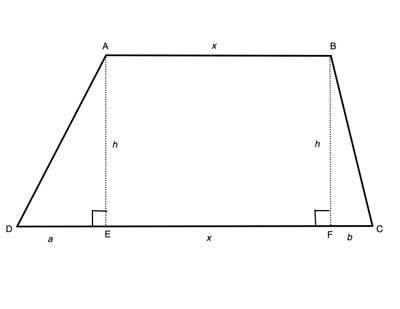It is often possible to find the area of polygons with irregular shapes by dividing them into smaller shapes with easily computed areas, like triangles and rectangles. Sometimes this leads to a simple function for the area of the polygon, as is the case with a trapezoid.
Problem
Find a formula for the area of a trapezoid using its height and bases.

Strategy
We will divide the trapezoid into triangles and rectangles, whose areas we can compute easily. We will rely on the fact that in a trapezoid, the bases are parallel to each other.
The Problem asks us to find the area using the height of the trapezoid - so let's do that, and construct two lines which are perpendicular to the longer base, AE and BF, from the corners of the shorter base.
Since we constructed both lines as perpendicular to the base DC, then the AE and BF are parallel to each other by the Converse Perpendicular Transversal Theorem.
As a result, the quadrilateral ABFE is a rectangle - it has two pairs of parallel sides (making it a parallelogram), and interior angles that measure 90° (∠AEF=m∠BFE= 90°). In a rectangle, like any parallelogram, the opposing sides are equal, so AB=EF=x, and AE=BF=h.
The area of the rectangle is x·h, and the area of the two triangles is a·h/2 and b·h/2, respectively. The area of the trapezoid is the sum of the areas of the two triangles and the rectangle - x·h+a·h/2 + b·h/2. combining like terms we get (h/2)·(2x+a+b), or (h/2)·(x+x+a+b). But x is simply the short base, and x+a+b is the long base, so the simplified formula for the area of a trapezoid is (short base+long base)·height/2.
Solution
(1) AE ⊥ DC //Construction
(2) BF ⊥ DC //Construction
(3) AE || BF //Converse Perpendicular Transversal Theorem.
(4) AB||DC //Given, ABCD is a trapezoid
(5) ABFE is a rectangle //(3), (4) - definition of a parallelogram, (1), (2) definition of rectangle
(6) AB=EF=x //Opposing sides of rectangle are equal
(7) AE=BF=h //Opposing sides of rectangle are equal
(8) AABCD=AABFE+AAED+ABFC //Area of trapezoid is sum of area of its parts
(9) AABFE=x·h
(10) AAED=a·h/2
(11) ABFC=b·h/2
(12) AABCD=x·h+a·h/2 + b·h/2=(h/2)·(2x+a+b)=(h/2)·(x+x+a+b)
(13) AABCD=(short base+long base)·height/2
